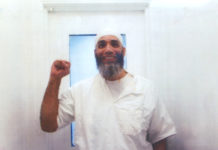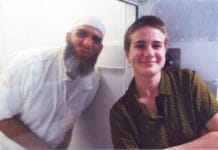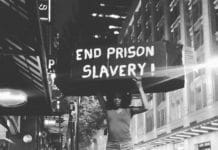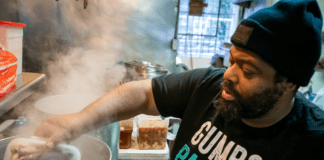
Treasure Islanders are being forced to breathe construction dust carrying an added load of death from radiation and chemicals during a pandemic in which, on April 2, Aljazeera reported that 1,002,000 people have been diagnosed with the COVID-19 disease worldwide, while 51,000 around the globe have died.
by Carol Harvey
Poverty is a pre-existing condition
Twenty years before COVID-19, poor and people of color, some with disabilities, and low- and middle-income market rate renters were subjected to the island’s high winds carrying toxic dust creating a respiratory disease cluster. This pre-existing condition makes Treasure Islanders far more vulnerable than the general population to a virus which attacks and may harden lung tissue, rendering people unable to breathe and killing them rapidly.
Harvard study links pollution to COVID-19 deaths and to environmental racism
“Pollution is linked to higher COVID-19 deaths,” announced a Marketwatch.com headline on Wednesday, April 8, 2020.
The next day, April 9, as the New York Times reported global deaths from coronavirus approaching 100,000, the U.S. newspaper of record echoed Marketwatch: “New Research Links Air Pollution to Higher Coronavirus Death Rates.”
Both publications cited a study from the Harvard University T.H. Chan School of Public Health. The Times stated that this study is part “of a small but growing body of research, mostly still out of Europe, that offers a view into how a lifetime of breathing dirtier air can make people more susceptible to the coronavirus, which has already killed more than 10,000 people in the United States and 74,000 worldwide.” Marketwatch underscored environmental classism and racism, emphasizing, “It’s the latest link showing that pollution from burning fossil fuels CL00, -6.26% to power businesses, homes and cars – especially in higher-population concentrations and under-resourced neighborhoods mostly populated by people of color – can have a direct link to the magnitude of health crises.”

RAB meets despite pandemic
For the first time in six years, since February 2014, I chose not to attend the March 10, 2020, Treasure Island Restoration Advisory Board meeting. I shoot the only videos documenting Navy updates of its well-concealed radiological and chemical cleanup.
On March 9, 2020, I emailed Joe Schwennesen of Adanta, Inc., a Napa, California, environmental service the Navy picked to take over RAB meeting facilitation from Tetra Tech after its employees went to federal prison for faking and corrupting Hunters Point’s radioactive soil samples.
“Hi, Joe. I won’t be attending the Tuesday, March 10, 2020, RAB meeting. My non-attendance is solely and only because the San Francisco Department of Emergency Management has announced 11 cases of coronavirus (COVID-19) in city hospitals.
“This virus is moving uncharacteristically fast. One of my friends has died from respiratory disease complications from this virus. An Island resident informed me today he is feeling ill from respiratory symptoms unique to this virus.” A coronavirus cluster was suspected to exist on Treasure Island.
In follow-up, I wrote, “I have not heard from you as to whether the RAB is planning to meet in the face of this public health risk.”
Joe responded: “Yes, I am concerned, too. However, it is the Navy’s decision, and as of this writing they are going forward with the meeting as planned.”
I knew chairs in the narrow meeting room in Building One were less than a foot apart and that visiting Navy personnel and regulators could introduce viruses from Oakland and San Diego.
After the meeting, I emailed Bob Beck, island director:
“I avoided the 3/10/20 RAB meeting solely and only because of the COVID-19 pandemic. I knew from contacts that sick people attended the meeting with sneezing and coughing throughout.
“The incredibly irresponsible act by the RAB and the Navy of holding this RAB meeting on March 10, 2020, in the face of the growing coronavirus pandemic and despite the San Francisco Alert to not hold meetings speaks eloquently to the Navy’s total lack of concern for the health of people anywhere, but especially on Treasure Island.
“I am outraged that you held this meeting, and I intend to make my opinions publicly known.”
Beck responded:
“Ms. Harvey,
“Having attended the meeting, I can attest that the description of that (sic) was communicated to you is inaccurate. There was not ‘sneezing and coughing throughout’ nor did I observe anyone that I could say was clearly sick. The Navy did provide hand sanitizer and packets of sanitary wipes at the sign-in table.
“Thanks
“Bob”
Residents in attendance reported that the Island’s co-chair, Alice Pilram, sneezed and coughed throughout the two-hour meeting. No one mentioned seeing hand sanitizers or wipes.
Construction orders during the coronavirus pandemic
Mayor London Breed issued special construction orders protecting residents and workers by limiting the kind of building projects allowed in San Francisco.
“Essential construction projects may continue, provided that they carry out the work in compliance with social distancing requirements.
“Creation of new housing units, including both market rate and affordable housing units, is essential. Construction projects can proceed and new ones can begin if they contribute new residential housing stock to meet the County’s critical need for additional housing supply.”
Profit over people
It is a fact of life in San Francisco that people with money and power generally get their way.
Developers may present the convenient argument that construction on Treasure Island is essential because it adds to the City’s affordable housing stock, but no housing, affordable or otherwise, can begin for two to 10 years. In the Bay Area, “affordable” seems a contorted rationalization. Rents are ridiculously off the charts – far too high for even middle income families, not to mention the subsidized poor.
It is widely understood that the Yerba Buena Island-Treasure Island redevelopment enterprise is the largest vanity project in the Bay Area. The central building on Yerba Buena Island will contain expensive condos with a tiny “affordable housing” component.

It is also generally known that, while both Yerba Buena Island and Treasure Island will be redeveloped with condos for the rich, many small businesses and a resident population of poor and people of color living on Treasure Island at sea level far below are being compromised by toxins and wind-blown construction dust.
Adding insult to injury, years of Treasure Islanders’ market rate and subsidized rents have been financing redevelopment housing for the wealthy. Island businesses and residents have been asked to fund through various fees transportation infrastructure on and off the island for wealthy future condo owners.
Safety, security and habitability
Breed’s construction orders carefully safeguard security, sanitation and habitability of buildings. But what if construction actually endangers the health, safety and habitability of island business owners and residents?
While all other non-essential work must stop, redevelopment construction continues throwing up dust.
In 2014, San Francisco Fire Department specialists informed me that ambulances carry asthma patients most frequently to off-island emergency rooms. They felt that the most common illnesses on Treasure Island are respiratory diseases caused by people breathing particulate matter.
Inhaled dust alone forces the lungs to labor and can cause heart failure. In the COVID-19 pandemic, where the focus of the illness is a lung disease, it’s unbelievable that developers are continuing construction in this neighborhood of respiratorily compromised people with pre-existing environmental conditions caused by wind-blown dust.
C8, the “forever chemical,” never breaks down in the human body and is linked to ulcerative colitis, high cholesterol, pregnancy-induced hypertension, thyroid disease, testicular cancer and kidney cancer.
This construction, if not blatantly illegal, seems terribly dangerous and irresponsible in a pandemic where the coronavirus attacks the lungs. Particles floating in air render inhabitants more vulnerable to a disease that hardens lung tissue to the point where the sufferer can’t breathe.
Additionally, Treasure Island continues to be radiologically and chemically contaminated. Truthout reports the EPA’s cruel April Fool’s joke, indefinitely suspending environmental rules amid the worsening coronavirus pandemic. This relaxation of regulations gives the Navy “a green light to pollute” and also neglect to transparently and fully report their cleanup of, for example, a toxin found adjacent to the housing area.

Deadly PFOs and PFOAs (perfluorooctanoic acid), were left over from controlled burns conducted at the Navy’s old firefighting school in the block bordered by Northpoint Drive, Avenue M and 14th Street. Called Site 6 by the Navy, this large square swathe of soil sits between the wastewater treatment plant with its “fragrant” smells and the lane running to the shore where windsurfers glide their boards through toxic waters.
PFOA and PFO, also known as C8, is a chemical with stain and water resistant properties used worldwide in firefighting foam and sealants, as well as Teflon lining in electric frying pans, carpeting, upholstery, apparel, floor wax and textiles. This “forever chemical” never breaks down in the human body and is linked to ulcerative colitis, high cholesterol, pregnancy-induced hypertension, thyroid disease, testicular cancer and kidney cancer.
Three thousand five hundred people with cancers who lived or worked near a Dupont plant in Parkersburg, West Virginia, are suing the company over exposure to C8 released into their drinking water.
This chemical contamination was the subject of a recent film, “Dark Waters,” which follows Attorney, Robert Bilott, played by Mark Ruffalo, in the lawyer’s legal battle against DuPont over the release of toxic C8 into Parkersburg, West Virginia’s water supply, affecting 70,000 townspeople and hundreds of livestock. C8 flows globally from there through waterways and oceans and is now present in 99.7 percent of American’s blood and the bloodstreams of global populations. This violent toxin most probably has been present on Treasure Island for years.
Furthermore, Treasure Island developers can’t produce any new housing to meet immediate demands. They have barely reached the preliminary stages in which large vibro-compactors are shaking down the dirt, and into which bores are injecting hardening agents to protect soil from settling over time, or stabilize it against sudden liquefaction in earthquakes and tsunamis. The final grading of the topsoil in which infrastructure will be buried, or on which any of the affordable housing units will stand, is five to 10 years away.
This is not the only delay. Though the Navy has remediated and turned most of the island over to the City, it projects that its quarter century of remediation, specifically, the toxic cleanup of the soil, air and water, under, above and around Site 12 townhouses in the community area will take two to five more years. This explains the Navy’s urgency to hold the RAB meeting and convince the developers the cleanup is moving along toward completion.
Until the Navy completes this detoxification and residents are transferred to other housing on or off the island, neither the original wastewater treatment plant nor the community it serves can be demolished. Only then, can the soil be vibrocompacted, reinforced and graded in concert with the rest of the island and the homes replaced by wetlands, wildlands and parks for tourists and visitors in the area facing the Golden Gate Bridge.
In the meantime, clouds of construction dust continue to damage the lives and health of current residents.

On Saturday, March 21, I began receiving emails and calls from Treasure Island residents reporting that, starting at 7:00 a.m., they heard construction noise for the entire week the coronavirus story was breaking. Several people emailed photographs of the enormous construction area stretching between 13th and 10th streets several blocks along the shoreline facing Berkeley. TIDA officials confirmed that the ground was being vibro-compacted, solidified and graded for construction of a new wastewater treatment plant.
At 11th Street, in a section of former Avenue M which has been completely removed just north of the Ship Shape Building, a gate opens into this site allowing passage of heavy trucks. Inside this gate people could see yellow graders shoving around mounds of soil. A dozen or so smaller vehicles continually circled these huge machines.
Gray derricks loomed like elbows above the horizon containing bores that inject a kind of “grout” into the loosely-packed fill.
East toward Clipper Cove near the old Navy pier, inside an active materials site bounded west to east by Third and Fourth streets, and north to south from Avenue I to Avenue H, trucks were seen loading up with fill.
At both sites, residents observed clouds of dust tossed up by loaders dumping gravel aggregate into trucks. Gravel aggregate is far less safe to breathe than soil dust because it may give off rock particles containing large amounts of granite.

Islanders emailed describing island life in the pandemic.
Like all San Franciscans, they labor under the same safety orders in effect from Thursday, March 27, until April 7, 2020.
Stay home except for essentials. If you need to go out, stay at least six feet apart from other people. You may walk, bike or go for a run near your home.
Look out for one another. Check in with older adults and those with underlying health conditions who are the most vulnerable to the virus or may be isolated during this time. Call, email, or talk through the door. Limit face-to-face interactions with anyone particularly vulnerable to coronavirus.
Some wrote that the island feels abandoned and desolate. As far as one resident could tell, a couple of businesses are still offering food. “Abdo and his family are keeping both stores open, thanks be to God,” they said.
People are driving each other and picking up supplies for their neighbors from the Treasure Island Market and Deli in Building One at the island’s entrance and from the Island Cove Market, mid-island at Avenue H. The owner, Abdo Nasser, often treats customers like extended family.
Residents have written that this store is well-supplied because, though Abdo’s prices are slightly high, he orders an amazing array of goods. He also on occasion extends credit. My correspondent assures me that they always pay him back.
“There were some postings a while back where people were trying to find ways to get some food to the island for people that depended on the food pantry, free fruit and vegetable pick-up supplied by the Food Bank to the Ship Shape Building near the large construction site at the back of the island along what used to be part of Avenue M.
My correspondent has been calling around for food. “Safeway has not come out here in years.” They did find a farmer’s cooperative. “Someone told me to try Whole Foods.”
“Restaurant deliveries have dropped to zero even before the pandemic, and Uber and Lyft delivery has stopped too. Sigh. Kind of sucks.
“People are helping one another where they can. But, TIDA, nah.
“Have not heard a peep from TIDA or YMCA. All the social services are pretty much shut down.”
By preparing to build purely cosmetic vanity dwellings for the rich, developers and contractors are out of compliance with San Francisco’s stop work orders. These homes are not being built to guarantee safety, security and habitability for San Francisco citizens.
No health care is being offered on Treasure Island.
Of the state of health on the Island, my correspondent continued, “My guess is at least a third of the island is immune-compromised.
“The nursing office is closed down. I have been directed to nearby clinics if I am in need of urgent care.
“Really, it’s pretty dead out here. I’m sure there are cops around. But, security cars, I honestly have no idea.
“It is surreal how quiet it is out here. I am SERIOUS! No loud music. No smell of weed smoking. No kids screaming and yelling. Occasionally see a lone exerciser or basketball game.
“People keeping a half block ahead of everyone as we walk our dogs.”
“Paying rent is going to be interesting. John Stewart said to pay by check, not money order. Catholic Charities for years has only accepted debit cards.”
Island residents may be protected by state and city eviction moratoriums.
ABC, KGO, Channel 7 reported that on March 27, 2020, in the midst of the novel coronavirus pandemic, Gov. Gavin Newsom issued an executive order putting a moratorium on the eviction of renters affected by the coronavirus and the economy’s downturn.
San Francisco’s moratorium on evictions started on March 23 and will last until June 21. Landlords may not “attempt to recover possession of a residential unit unless due to violence, threats of violence, or health and safety issues.”
Tenants are still responsible for paying their rent. They must notify landlords about their hardship within 30 days of the rent being due and every time they miss a payment. San Francisco allows a six-month repayment plan for every month of rent missed. Landlords may assess any late fees expressly written in their lease.
Another resident wrote, “Decided to go down to the Island Cove Market for a take-and-bake pizza.
“Now my feelings about the Island Cove Market have always been mixed (so) I get my groceries at either Target or Trader Joe’s 90 percent of the time.
“One thing I will say in their favor is that the staff is very friendly and respectful. So I talked with the owner for a minute. He said business was slow because they didn’t have the variety that most people wanted.
“That really surprised me because I see people lined up literally around the block to get into Trader Joe’s, Whole Foods, Safeway and a million other chains downtown. Sometimes they’re waiting out in the rain without practicing social distancing.
“Meanwhile we have a grocery store within walking distance that never has a line and the only downside is that they don’t have Chilean mangoes and you might pay more for a pizza.
“I think you should consider giving the Island Cove Market some publicity.”
“You are absolutely right. We are incredibly lucky to have them in our community right now.”

Developers defy pandemic construction orders
In defiance of City orders stating that “if a project is purely cosmetic and can be safely delayed, it should not continue,” massive amounts of dust are being raised in preparation for construction of condos on Treasure and Yerba Buena Islands. A few affordable, but far too expensive apartments will loom high above the Bay over spectacular views.
By preparing to build purely cosmetic vanity dwellings for the rich, developers and contractors are out of compliance with San Francisco’s stop work orders. These homes are not being built to guarantee safety, security and habitability for San Francisco citizens.
When they are built, most middle and low income – not to mention all homeless – people will not be able to afford them. In the meantime, though islanders may not immediately feel the effects, construction dust is putting their lives at extreme risk.
Carol Harvey is a San Francisco political journalist specializing in human rights and civil rights. She can be reached at carolharvey1111@gmail.com.

 Store
Store









